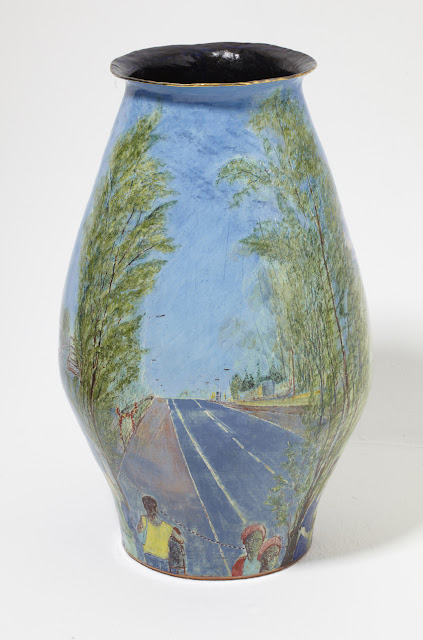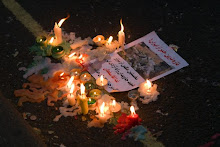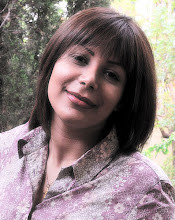Images from top:
1. St. Mark of the Farm (left) and Wedding Procession (right)
2. St. Mark of the Farm
3. St. Mark of the Farm
4. Wedding Procession
5. Wedding Procession
6. Wedding Procession, (detail)
Introduction
Two pots, both based on classical storage jar shapes and
painted around the circumference as a frieze, depict verdant landscapes, dominated
by tall trees against blue-grey, English skies. Both feature teams of white,
plumed horses, swanky cars and quantities of bling. They appear similar at
first glance but the events taking place within the landscapes could hardly be
more different. ‘Wedding Procession,’ commemorates the marriage of Prince
William to Catherine Middleton in April 2011. The event and the way it was
mediated affirmed the continuity of monarchy and the power of the state. ‘St.
Mark of the Farm,’ is a record of the funeral of Mark Duggan, who was shot by
police on August 4th 2011, precipitating four nights of rioting.
Duggan’s story is still extensively mythologised. He is, at once, the Hero:
‘people looked up to him;’ Villain: ‘Starrish Mark, leader of the notorious
Star gang;’ Saint: ‘he was a lovely guy, everyone knew him, he wouldn’t hurt a
fly;’ and Martyr: ‘a fallen soldier.’ His funeral, all in white, with white
lilies on the casket like the virgin bride, was in September, six months after
the wedding. The similarities in appearance were beguiling but they served only
to emphasise the vast social difference. It was a spectacle of inequality, a
mis-matched pair that bookended the summer and seemed to define the troubled
social politics of the time.
Wedding Procession
The Royal Wedding was a brilliantly choreographed spectacle
and a thoroughly crafted conceit, where sharp contrasts and rigorously
controlled separation together defined the illusion of a shared national drama.
The pot form provides a stage where the separation and
contrasts become visible. We cannot see the bride in her carriage because she
is obscured by trees. At the event itself, the public were separated from
royalty by both the physical barriers and the carefully mediated story, a richly
embroidered fairy tale. The public are ‘below stairs’ on the pot - below the
outermost curve. The separation is emphasised by the receding perspectives
above and below the curve. The wedding procession itself takes place on the
upper section among the trees, reaching up towards the skies.
This was the first of the English royal weddings to
encounter and be captured by popular mass communication. The public are
depicted photographing the event, a forest of outstretched arms pointing their
camera phones towards the glimpses of procession visible through the trees. Of the images uploaded to the internet, the most
photographed part of the wedding was the runaway horse whose journey was
captured at every stage. The official ‘central’ figures were marginal by
comparison.
To make the pot, I looked at an endless stream of
flickering, moving, transitory and, often, ephemeral images and painted and
fired a selection of them into a material that lasts for thousands of years –
icing on the fictional cake perhaps.
St. Mark of the Farm
Set in and around Tottenham and the Broadwater Farm estate,
St. Mark of the Farm shares many visual and narrative elements with Wedding
Procession. The trees, the procession and the white, plumed horses suggest a
wedding, but this is a funeral. It is a deeply personal, family event where
sorrow and loss mix with pageantry, spectacle and a suppressed public interest.
Duggan’s story is also highly fictionalised, the romance of the ‘villain’ who
dies a saint. The landscape, which embraces this drama is, par excellence, a
romantic urban construction, simultaneously historic and contemporary. It is
the landscape through which I walk daily to work, from my house in Tottenham,
right by ‘the Farm,’ as the estate is known locally, to my studio in Wood
Green.
Standing in Broadwater Farm, which wears its inner city
notoriety like a badge of honour, is a confusing experience, particularly at
dawn or dusk in winter when it feels mysteriously rural. At these times, this
large estate often falls silent. The Moselle river, which was once reduced to a
foul, concrete lined ditch in the 1960s, is now being retrieved with help from
a lottery grant, and snakes along the bottom of the willow-tree lined valley
with Alexandra Palace glittering in the distance. The last of the day light
glows pink in the damp, starting-to-flood, valley floor and the moon appears
above the roof tops to the south. At these times you can almost hear the cows
mooing – it was a dairy farm until well into the mid-twentieth century and was
then converted to allotments. Because of the flooding, there were no buildings
until the estate was built in 1965 and the Moselle was forced, reluctantly,
underground. Like all rivers it refuses to stay there and reappears every
winter in the form of floods which, in turn fill with geese, gulls and
migrating birds, adding the extraordinary rural illusion. Mark Duggan grew up
on this estate. His family are still there.
The pot uses all the elements of the landscape and
exaggerates and idealises them to enhance the narrative. The idealised Mark,
the saint, the ‘family man,’ is suggested by the evening landscape with the
river, which is borrowed from the background landscapes of pre-renaissance,
religious paintings. The three distinct scenes are those of the birth and early
life, the death, and the funeral. The death landscape is Tottenham Hale, a low
horizon line, bleak, empty and soulless, a reality of the place itself and an
inescapable metaphor. The Farm is, co-incidentally, the lowest point in the
landscape for some miles around, so the only way out of the estate is up hill. The
blocks of flats were built on giant concrete stilts, with aerial walkways
instead of streets because of the flooding and these too have become part of
its notoriety and mythology. The cemetery at Wood Green, where Duggan is
buried, is, by contrast, on the brow of a hill, commanding a fine view across
north London. It is here, at the funeral in white, that Duggan completes his
transformation from villain to hero to martyr and finally to saint.
The Role of Landscape
I made the pots to remember and to witness the events they
depict. I chose to emphasise the image of the landscape in which they occurred as
a metaphor for the construction of social myths. What constitutes an urban or
rural landscape cannot be taken for granted. Urban landscapes can be much more
verdant than their rural counterparts and are often, wealthier, less
industrialised and more nurtured. The rural ‘idyll’ is more apparent in the
wealthier parts of London, with its carefully selected native English trees and
artfully tended ‘wild’ areas, than in small-town England, where industrial
farming is in a state of decline and rural poverty results in neglect. The
Royal Wedding took place in central London, the centre of power and wealth and
the seat of government and monarchy. In this setting, it also resembled a
magnificent mythic hunting scene from a Renaissance tapestry – a resemblance I
sought to repeat on the pot by introducing exotic birds in the trees and
flattening the perspective.
Mark Duggan’s funeral took place in one of the poorest parts
of London. One might have expected a landscape of bleak estates, broken windows
and impressive graffiti. But this kind of grit-chic is another romantic urban
construction, generated in the studio for music videos. There is certainly nothing
like it in Tottenham in late summer. On the contrary, the traces of its rural
and prosperous past are splendidly visible at this time, in both parks and
streets, where the vast mature Willows, Oaks and Ash dominate the landscape. Wood
Green also carries the memory of a prosperous suburban history. ‘Arcadia
Gardens’ is not a fiction – or not on the pot anyway. That really is the name
of the road.
Landscape does, however, become a part of the political
analysis of spectacular inequality if we compare the image of the Royal couple
in the Aston Martin in the Mall with the remarkably similar image of Tottenham
Hale, where Duggan was shot. The low horizon lines are similar and both images
are framed with abundantly leafy trees. While the Aston Martin and balloons are
the decorative feature of the royal landscape, the road at Tottenham Hale
appears to go nowhere and the only decoration is the cascade of synthetic
flowers adorning the railings, a shrine to the ‘fallen soldier,’ or
rehabilitated ‘saint.’

















































